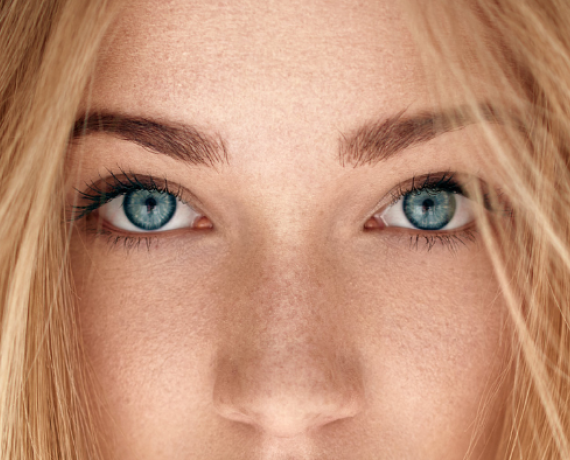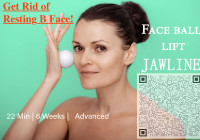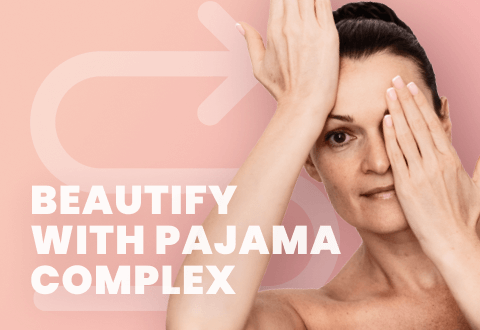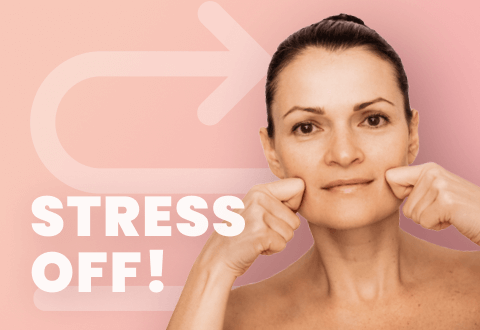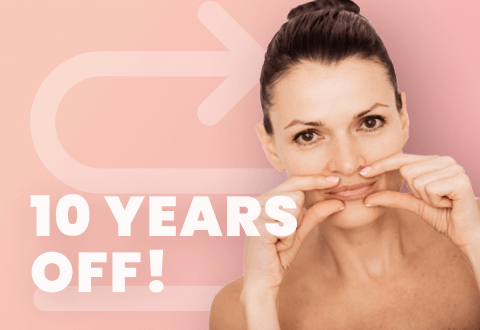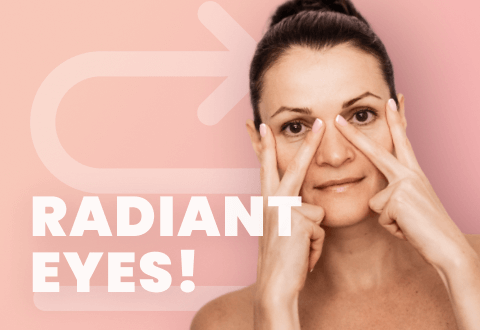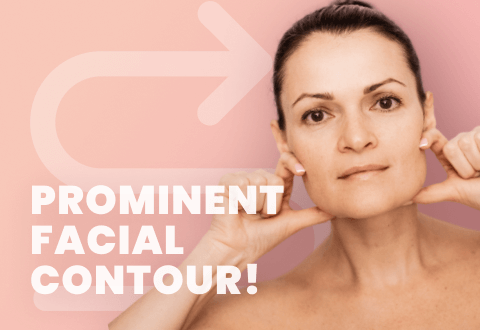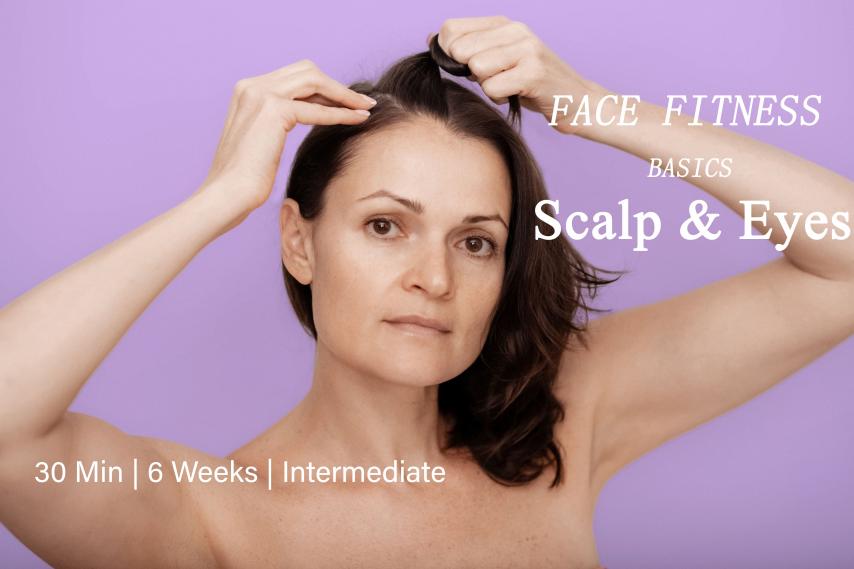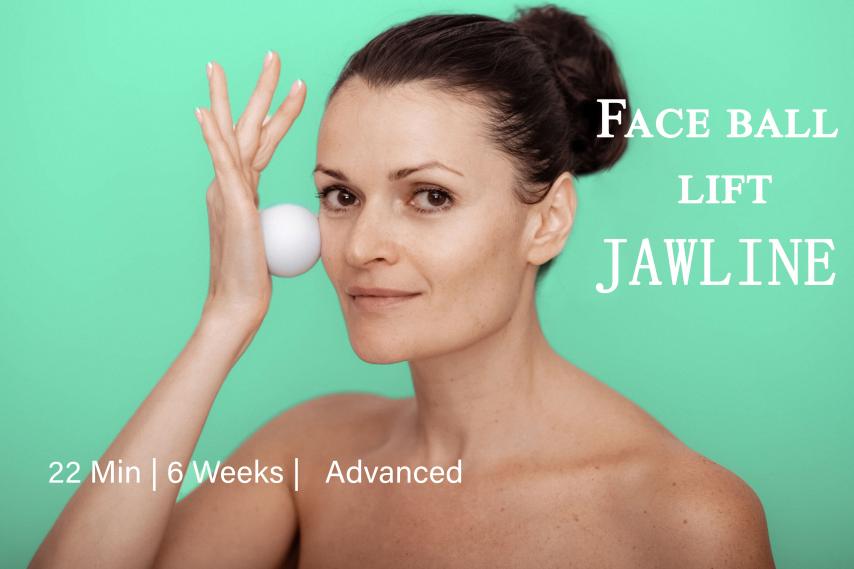Today i want to share absolutelly genius article about myofascial facial massage from Dr. Jared Edward Reser, Ph.D. USA. Dr. Jared, holds two Master’s degrees and a Ph.D. in brain and cognitive science from the University of Southern California.
Why Use Myofascial Facial Massage? What Are the Benefits of Myofascial Face Massage?
Fascia tends to become stuck within the layers of the skin and muscles which can increase the appearance of fine lines and wrinkles. Myofascial face massage can release stuck fascia and may stimulate restorative cellular activity to tighten the skin and tone the underlying muscles.
The tension in our faces drives the stress response, influencing us to feel anxious and breathe shallowly. The damage it does to the muscles makes our faces appear languid, overwrought, and weak. Deep tissue massage is the only way to counteract this. Compression and percussion will reinvigorate the muscle, increase blood supply, reverse muscle shortening, remove trigger points, decrease inflammation, and permit the muscle to grow.
The results can be dramatic because the long-term strain on our muscles is the leading cause of facial aging and loss of facial composure. These two issues are probably among the biggest sources of human insecurity. Both are not only preventable but reversible. If you want your face to look healthy and feel amazing, invest some time and effort in the myofascial facial massage regimen described here.
If you press your knuckles into your brow, your cheeks, or your jaw with between 5 and 15 pounds of pressure, you will likely feel an acute aching sensation. This pain may be so intense that it makes your breathing shallow and the pit of your stomach tight. However, if you spend 10 minutes a day compressing your facial muscles while breathing diaphragmatically, the pain will be gone within three months. The sagging, puffiness, and deposits of fat will go with it. You will be washing your face, and it will feel completely different. It will feel lean, smooth, and finely contoured. You will glance at yourself in a mirror or window and won’t recognize the leaner, angular, chiseled face looking back at you. You will look healthier, and that will help you feel healthier, too. Most importantly, your baseline level of stress will be significantly reduced.
Myofascial facial massage and acupressure are old arts. However, existing methods are not scientifically informed and intend to pacify the face temporarily rather than to relieve trigger points permanently. The method presented here targets the most pernicious myofascial restrictions in the face and guides you in systematically eliminating them. Once you work through these exercises, you will be able to relax facial muscles that you could not relax before, and you will have more precise control over your face’s movements. Eventually, you will be tension-free and able to comfortably and gracefully transition between expressionlessness and your full, healthy range of expressions.
Myofascial face massage illustration: Facial expressions
Myofascial face massage, Social Fatigue & Resting Bitch Face
When our face is continually tense, the people around us recognize it as a clear sign of self-perceived inferiority. My face was so tense that, whether someone was making a joke at my expense or complimenting me, I could not help but respond in a bashful, embarrassed way. A sheepish grimace would betray me constantly by showing others that it was easy to make me uncomfortable. By undermining my ability to stay composed and be assertive, it made me a target for mistreatment by unkind or unthinking people. Myofascial facial massage obliterates this submissiveness. If you rarely look uncomfortable, people learn quickly that they are the ones that will look bad if they try to bully you. Moreover, you will be able to keep a fantastic poker face. The person who can keep a straighter face usually controls the situation. These days I only smile when I want to, and I can even tell the punchline to a joke with a straight face. Even after a long day of gregariousness, I can easily assume a calm, expressionless demeanor.
Social fatigue occurs when prolonged social encounters become stressful, overwhelming, and cause a person to seek rest from social interaction. When you are experiencing social fatigue, people can usually see it in your face. It derives from the fatigue of facial muscles. When these muscles tire, or when their latent trigger points become active, it becomes depleting. They are draining to use, and this diminishes our ability to express and be friendly. Studies show that the amount a person smiles and makes socially engaging facial expressions are two of the best predictors of likeability. Using your face makes people want to be around you. But if your facial muscles are in perpetual fatigue, you can’t emote, and you will ultimately feel dejected.
“Bitchy resting face” (or resting bitch face) is a popular term for a facial expression (or lack of expression) that unintentionally appears angry or contemptuous. When we allow our face to relax more than usual, the tense muscles that we cannot relax become readily apparent and belie our attempt to appear calm. Before I started a myofascial facial massage regimen, no one ever saw my bitchy resting face because I never allowed my face to rest, even when alone. I was so self-aware of how bad my face looked at rest that I always sported a compensatory grimace. Our goal should be to massage the face until a complete resting face is no longer bitchy. We want to shoot for a wide-eyed, peaceful resting face.
Facial Microexpressions and Myofascial Face Massage Benefits
All of us are constantly making microexpressions with our facial muscles. A microexpression is an involuntary expression that is evoked by emotion. They are very brief and last between 1/25th and 1/15th of a second. It is thought to be very difficult, if not impossible, to completely suppress microexpression reactions. These reflexes largely dictate our genuine emotional reactions to what happens around us. Sometimes they turn out to be premature or socially unacceptable, and in these cases, we inhibit them and replace them with something else. If you find yourself compulsively thinking negative thoughts during the day, it is very likely that many of the automatic microexpressions you make are negative.
Most mammals that are not primates only wince when they experience physical pain. Primates take the innate facial reflex of wincing to physical pain and generalize it to social pain. Humans take it another step further. We wince when someone chastises us, but many of us learn to over-generalize our facial analogies, wincing even when someone congratulates us. Pained, maladaptive microexpressive habits like this are perpetuated by facial strain. Massaging the muscles using myofascial facial massage activities below will remove the frown, the cry face, the squint, the blush, and the sneer from the involuntary microexpressions that flicker across your face.
Myofascial Facial Massage Techniques and Targets
Releasing tension from your facial muscles requires the three techniques described in Chapter 6: percussion, compression, and vibration. We’ll start with a simple percussion exercise, following the protocol laid out in that chapter. Use a knuckle, knuckle tool (like the Jack Knobber or Index Knobber), a coat hook, baseball, softball, or Bonger to strike the dormant, tender muscles repeatedly.
Myofascial face massage illustration: A. Woman with major facial massage target areas marked with an “x”; B. Underlying facial anatomy
The area you massaged may feel slightly sore to the touch the next day. Even so, it should never hurt when not being touched. No part of your face should ever become chafed, swollen, bruised, or discolored; those are all signs that you are striking too hard or for too long and need to scale back. Don’t skip a day just because the area is sore. Gently working through the soreness day after day will keep the hypertonia from resurfacing.
There are also a few important notes about myofascial facial massage advisability.
- Do not massage your eyeballs, only the orbits around them.
- If you have injected filler, or any cosmetic substances into your skin, compression may not be safe.
- There are a wide variety of dermatological conditions that contraindicate massage, so if you have any reason to worry about your skin’s sensitivity, integrity, or safety, please consult your doctor prior to attempting myofascial face self-massage.
I have compressed tissues on nearly every corner of my face and have not experienced any injury whatsoever.
Myofascial face massage illustration: A. These are the best tools to use on the face. Do not use the smallest coat hook (third from the right). The tip is too small and thus works too well. It will reduce muscle tone so much that it will cause healthy muscle to atrophy. Pictured from left to right: three sizes of eyebolts (1’’ x 8’’; .75’’ x 12’’; .5’’ x 6’’), Jacknobber Index Knobber, Bonger. The smooth end of a Sharpie marker, or coat hooks with a rounded tip can also be excellent tools.
Much of the remainder of this chapter describes how to use myofascial face massage compression on every muscle of the face. After just six days of performing these exercises for ten minutes per day, for a total of an hour, you should attain noticeable results. The extent of the results will depend on your breathing. If you breathe five breaths per minute while performing the exercises, the results will be dramatic. If you normally breathe more than 15 breaths per minute, you may find that compressing the facial muscles is painful and that hard compression injures rather than releases them. If this is the case, you should return to this Diaphragmatic breathing and Facial beauty article and spend more time rehabilitating your breathing before continuing with this regimen.
There are many layers to the tension, and it may take months or years to achieve optimal results. Your progress should be consistent and readily apparent, however, and you should expect the gains you experience to be long-lasting. Most of the exercises can be performed from a standing or seated position. The ones that use a tool (especially the eyebolt) are best performed by placing the base of the tool on the ground or a flat surface and pressing the area of the face to be compressed into the top of the tool using the weight of the head. The diagrams below illustrate how this can be done with an eyebolt seated, kneeling, or lying down.
Myofascial face massage llustration: A, B, & C. Comfortable positions for facial compression. Ensure that the tool does not slip and bump into your delicate eyeball.
For each of the myofascial facial massage exercises below, you will be using a knuckle, finger, or tool to search for and press gently against the sorest muscles. Please see the compression protocol from Chapter 6. Move slowly across the area, ensure that each press overlaps with the last. Hold each press for two to ten seconds. Once you have massaged the whole area, start over. As you practice, maintain paced breathing
Myofascial Face Massage Around the Eyes: Orbicularis Oculi
Most people have bags under their eyes, although the bags can vary widely in shape, size, and color. Some people have dark circles. Others have a crease that runs from the inside corner of the eye diagonally down and away from the nose. It is often darker in color and sometimes black and blue. These are all due to tension in the lower portion of the orbicularis oculi muscle caused by perpetual squinting. This tension can be the cause of frequent crying. Before compressing this area, I would often feel on the verge of crying. Since massaging them, I rarely feel tearful. You should also find that you squint much less in sunlight.
Myofascial face massage illustration: Orbicularis oculi massage.
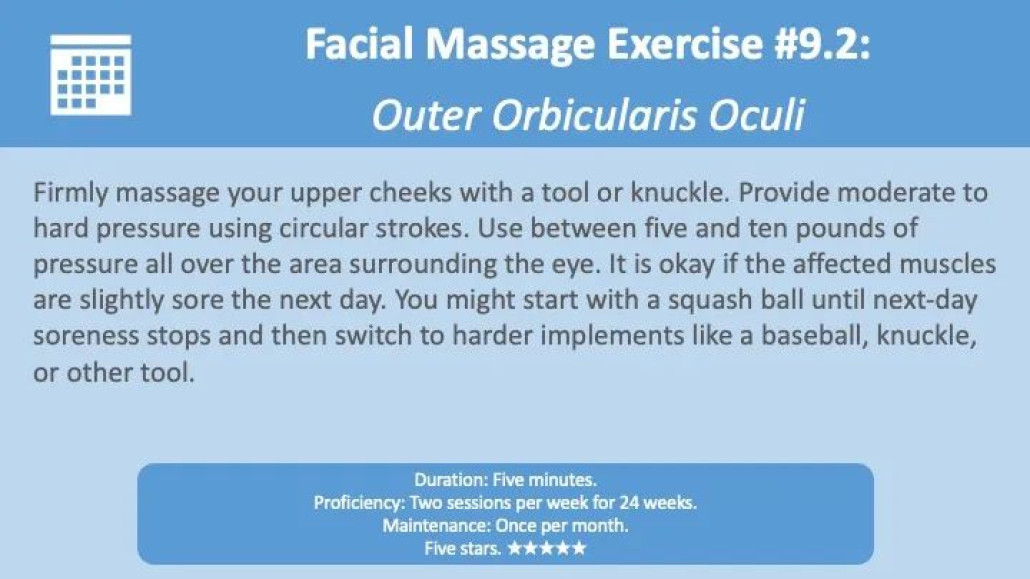
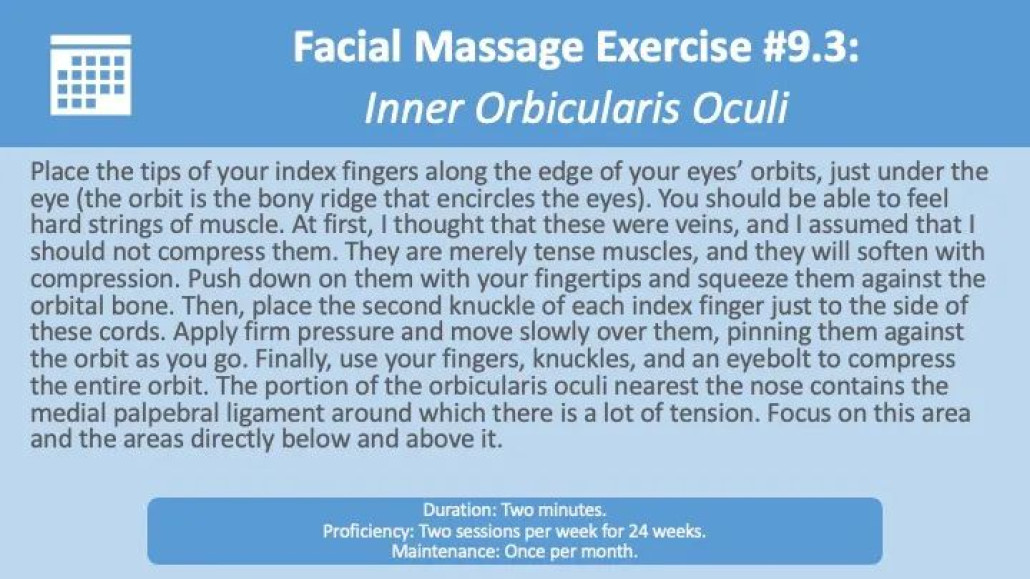
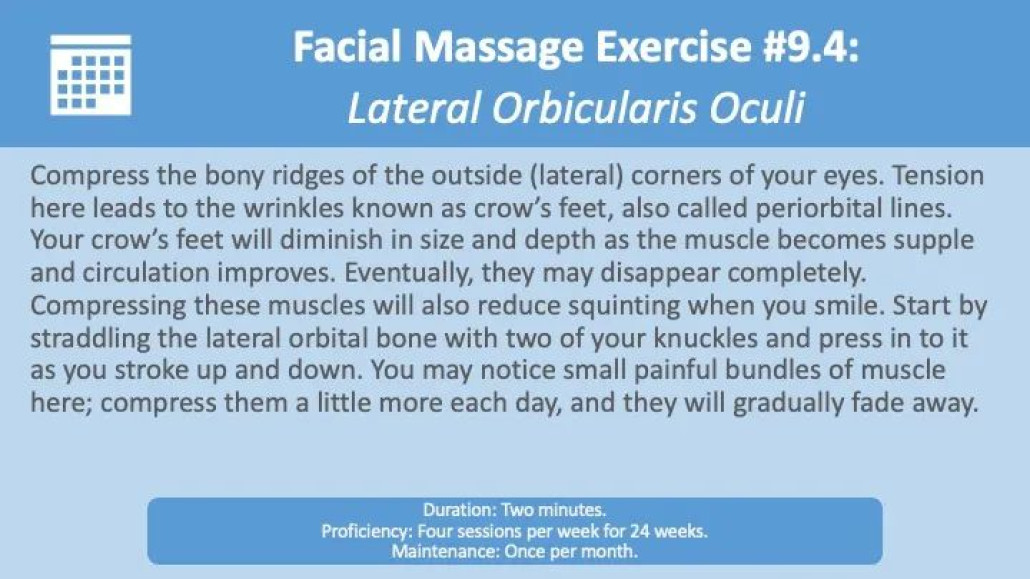
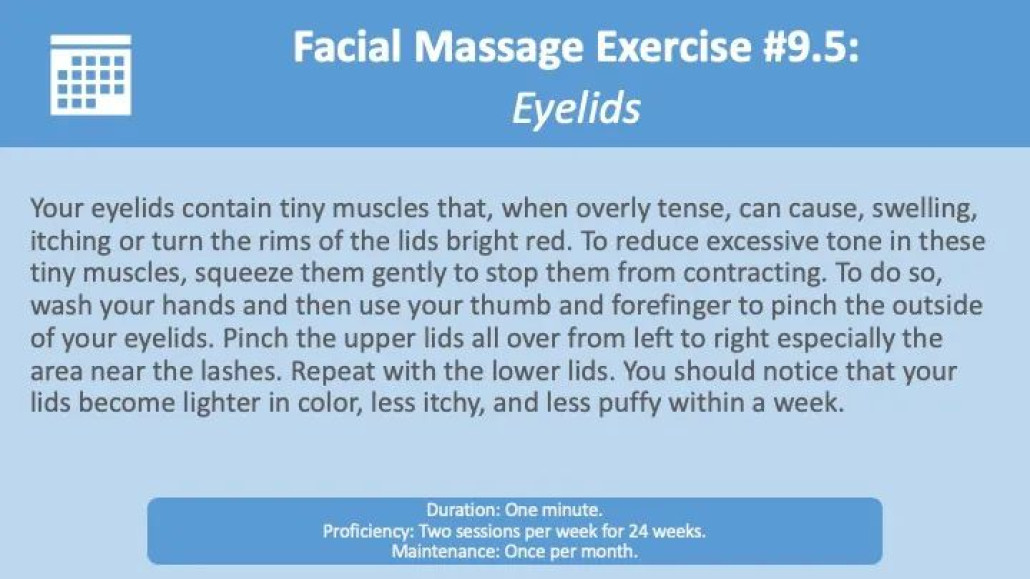
Myofascial Face Massage of The Brow: Frontalis, Procerus, and Corrugator Supercilli muscles
Most of us have very tense muscles in our foreheads and eyebrows. They become tense because we raise our eyebrows (frontalis muscle) when trying to make friends and furrow our brows (using the procerus and corrugator supercilli muscles) when we get angry. You might remember from Chapter 4 that the former are used by an animal being chased, and the latter are used by an animal chasing. Over time, these expressions can become plastered on our faces, making the brow painful by our mid-twenties.
Brow muscles can be difficult to work on. It took me three months of massaging for about 5 minutes per day before the pain faded fully. But it was worth it because it also got rid of sizeable knots and scar tissue. Previously, those knots had kept my brow in a permanently raised state, making them tremble when I was upset or nervous. Releasing your brow muscles reverses this. It will also reverse the muscle shortening letting your eyebrows descend to take on a fearless look. Your eyebrows will keep still when you talk, and only raise when you want them to.
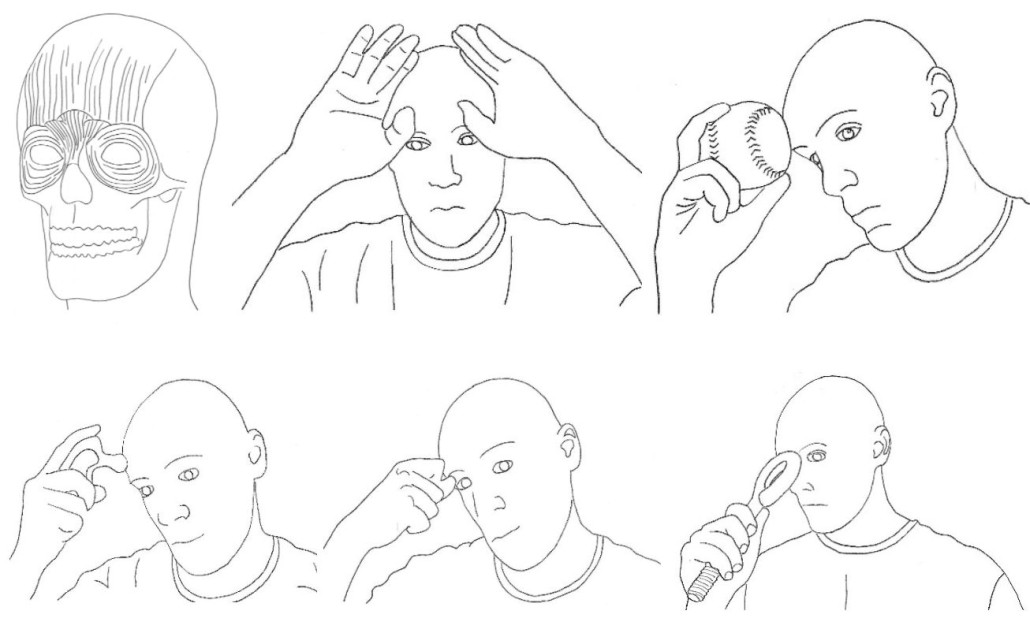
Myofascial face massage Illustration: Brow massage.


Myofascial Face Massage of The Cheeks: Zygomaticus Major and Minor, Levator Anguli Oris, Levator Labii
The zygomas are the bone protrusions on either side of the human face commonly referred to as cheekbones. They are the meeting point for multiple muscles that overlap to create an intersection of tension. That tension causes inflammation and swelling. Compressing the muscles and using myofascial facial massage techniques will reduce that swelling, uncovering your cheekbones and making them more visible and pronounced. It will also end chronic blushing and cheek tightness. I used to blush socially and every time I exercised. I never blush anymore.
Most smiling is nervous smiling. In fact, when we laugh or smile socially, our hearts are often beating quickly, and our breath is shallow and tense. As you know, any muscles that are routinely coactivated with distressed breathing will hold excess tension. In the case of the zygomatic muscles, that strain causes them to pull on tendons where they attach to the cheekbones, causing deep pain. The tendons become so strained that the area accumulates scar tissue and undergoes a host of degenerative cellular processes. This made my smile rotten and mangled. This was the sorest place on my entire face. Pressing a baseball into it with five pounds of pressure hurt so badly that it made me want to cry. There were tiny protuberances and what felt like sand in the area. Now it is smooth, and all the pain is gone completely.
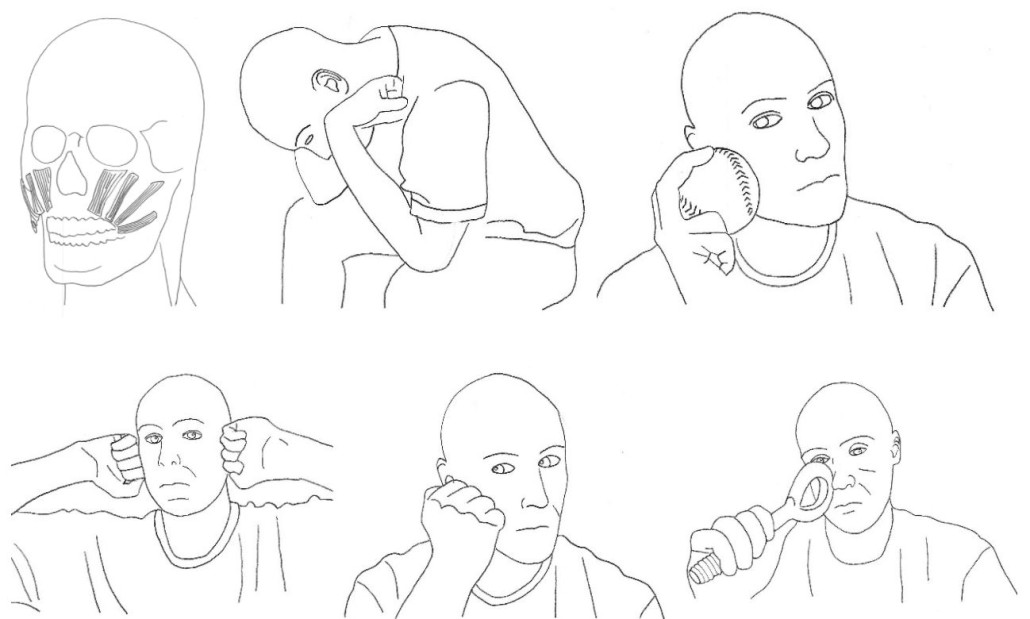
Myofascial face massage Illustration: Cheek massage.

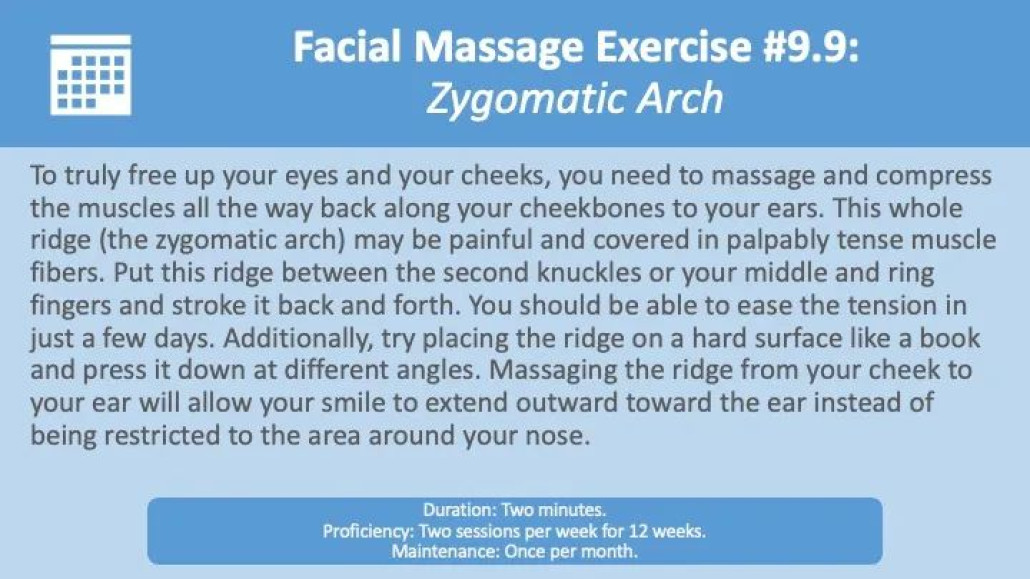
Myofascial Facial Massage of The Nose: Levator Labii Superioris
In most mammals, the sneer occurs more conspicuously on one side of the mouth, usually the left. You may have observed this in a snarling dog. Accordingly, I had a much larger knot in my left levator labii superioris than in my right. It was probably the largest knot in my face. It was about the size of three sticks of chewed gum. Releasing this muscle was empowering for me. After releasing it, I realized that I used to walk around with a permanent sneer on my face. The sneer would grow as I became uncomfortable, making me look sour. It was stuck in partial contraction with very little range of motion. Now that the muscles are at rest, I feel less defensive and less susceptible to provocation.
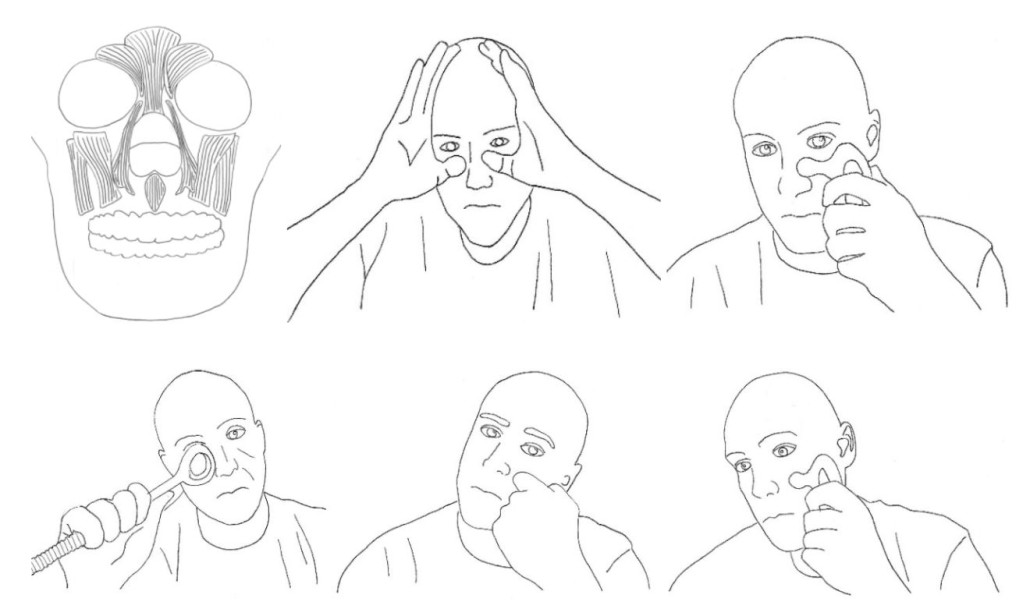
Myofascial face massage illustration: Sneer massage.
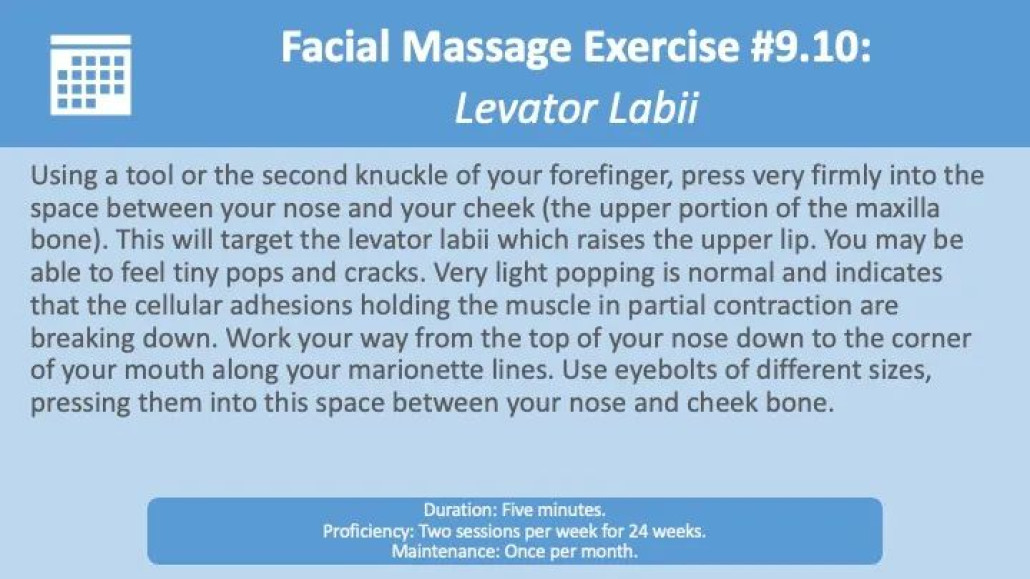
Myofascial face massage of the muscles on the sides of your nose will make the area appear deeper and leaner, giving you a friendlier, calmer look and allowing you to smile without sneering. I felt like blood-sucking leeches had been removed from the sides of my nose. In fact, I used to wake up every morning with a dull ache on the sides of my nose. Never again.

Most people sneer heavily when they smile, and over time, this causes the nostrils to shorten and become upturned. It looks ugly. Doing myofascial face massage exercises and compressing the nostrils (the alar portion of the nasalis, the dilator naris and the compressor naris) will reverse this. Also, compress the muscle under the nose (the depressor septi) with a knuckle or tool. In addition, you might put a towel down on the floor and press your nose into it, resting the weight of your head on it. Point the tip of the nose downwards, and rock back and forth to massage and compress tissues throughout the nose.
We all have a low-grade perpetual sneer burned into our facial musculature. All our lips are slightly curled due to this tension. Most people retain the coordination to relax the muscles involved but choose not to because it makes them feel uglier. I remember feeling like some kind of repulsive zombie-pig when I relaxed mine. By tensing the area, we apologize for and cover up the appearance of strained muscle. But over time, this only makes it worse. It is likely that the only time you relax these muscles is when you are exceedingly angry. Work on resting the sneer throughout the day and disregard any reservations you might have about how you look while doing this. Compressing the levator labii will remove the knots from your sneer and make it look natural to stop sneering.
People who raise dogs for dogfighting abuse them to get them to sneer. They punch, pinch, or cut the dog repeatedly until it learns to bare its teeth immediately upon provocation. They want the dog to live in a mental world where baring its teeth is the first reaction to any form of stress. This makes the dog mean. When a problem dog learns to bare its teeth at people, nipping and then biting soon follow. By relaxing and compressing your sneering muscles, you deprogram this reaction. From experience, I have come to believe that once the muscles that lift the upper lip are no longer tense, the brain’s circuits for frustration and aggression are keyed down.
Myofascial Face Massage Of Mouth and Lips: Orbicularis Oris
The right and left corners of the mouth are the point of attachment for muscles throughout the face. Muscles extending from the nose, cheeks, jaw and chin all anchor into these two corners. The bracing of our mouths and lips (orbicularis oris) is almost imperceptible. It is a subtle pouting that, over years, makes your lips thinner and your mouth appear shriveled. As you age, continuous pursing of the lips causes vertical wrinkles. Massage halts this.
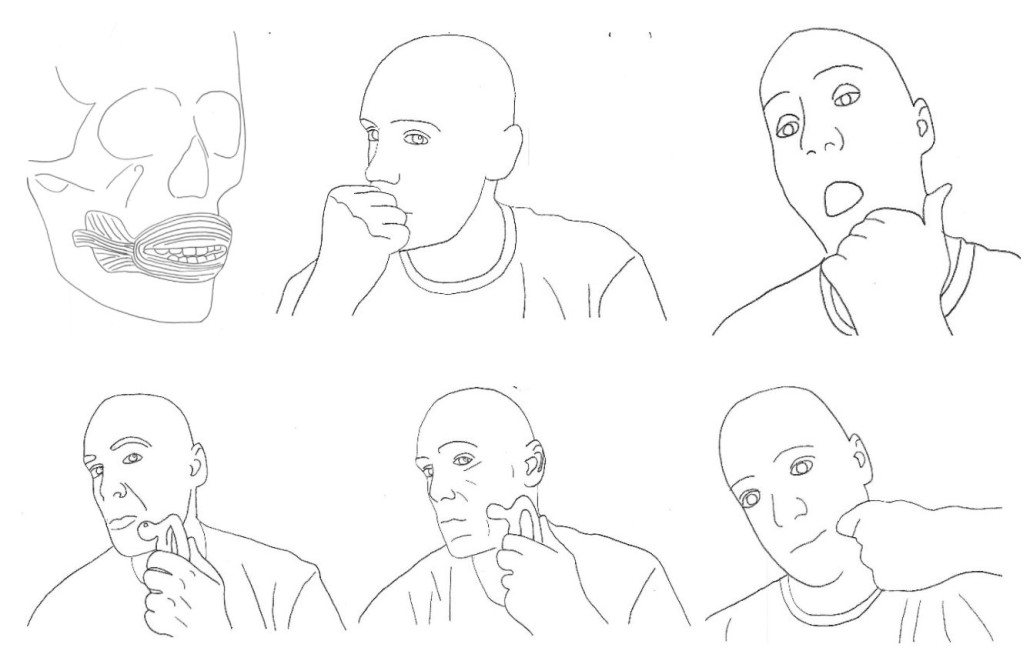
Myofascial face massage illustration: Mouth and lip massage.
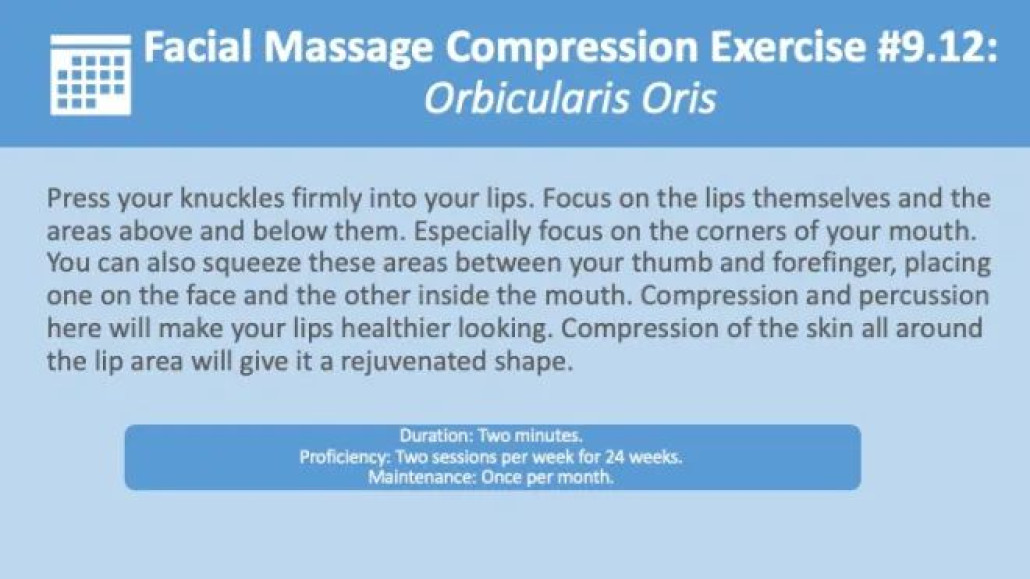
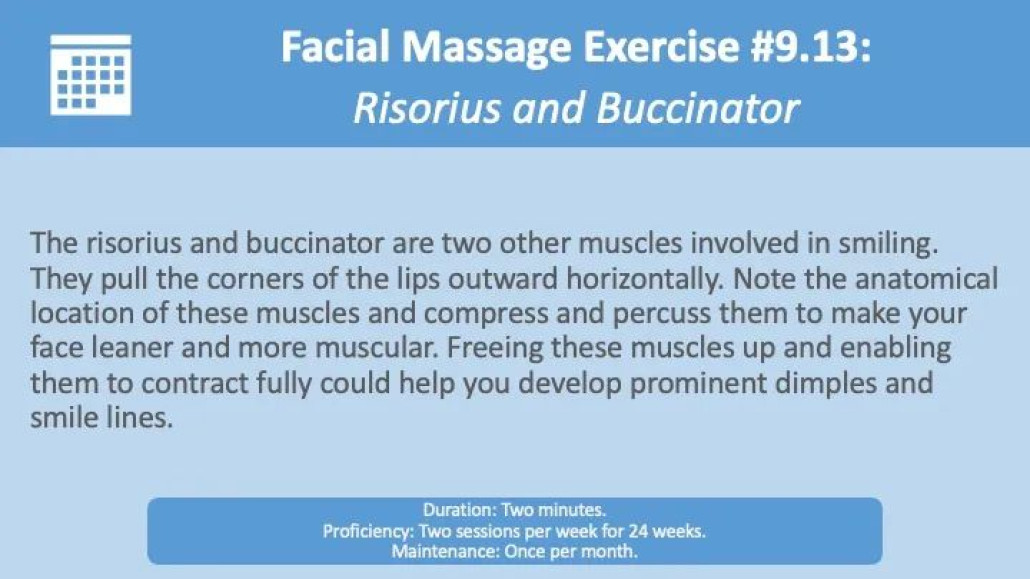
Myofascial Face Masssage Of The Jaw: Masseter
The masseter muscles that allow us to control our jaws are typically very tight. That tension can cause significant pain, restrict range of motion, and prevent the muscles from growing in response to chewing. For many people, the muscles are so tense that they are slow to release—expect this exercise to yield significant results only after several months. You also need to be careful to massage relatively gently here to avoid damaging the salivary glands that lie on top of the masseter muscles. The results will be worth it, though. In addition to relieving the pain, tension, and discomfort, you’ll enjoy increased jaw definition.
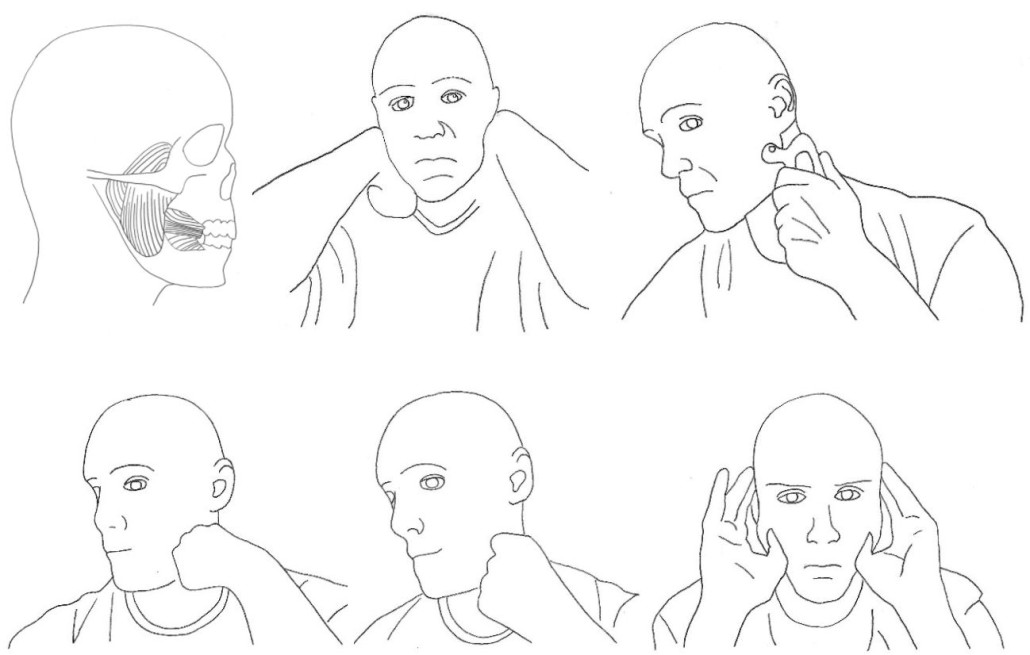
Myofascial face massage illustration: Jaw massage.
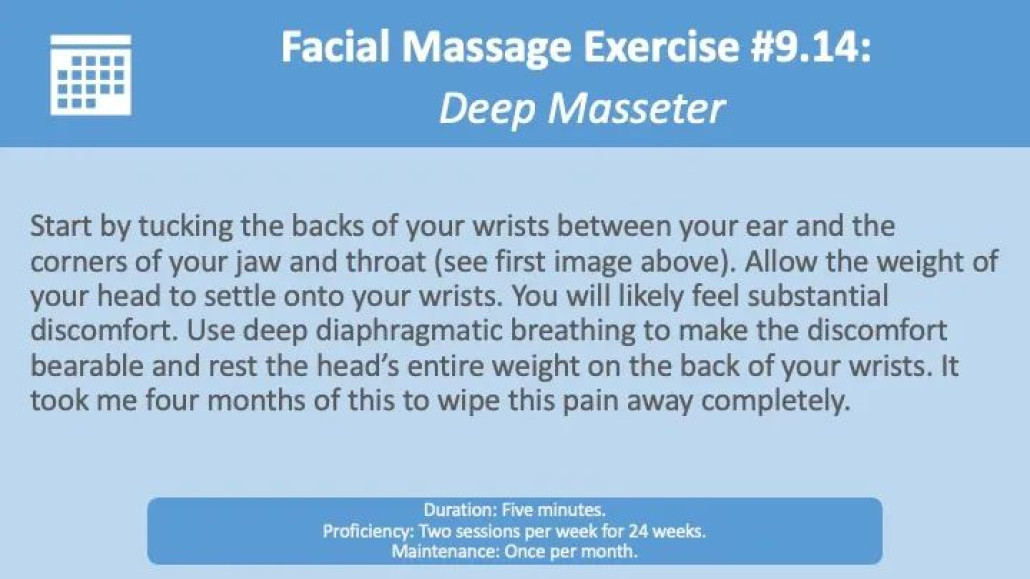
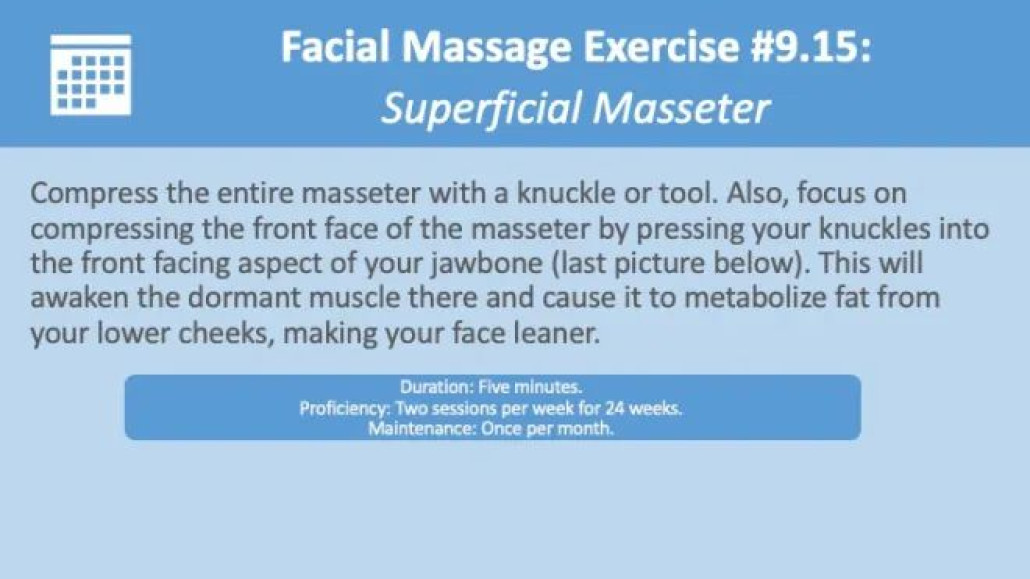
Myofascial Face Massage Under the Jaw: Platysma
Poor neck posture and failing to contract the muscles under the jaw makes these muscles weak and tight. Speaking in a high, tense voice may also cause them to become taught and atrophy. As that happens, substantial deposits of fat begin to accumulate under the jaw. If you can release these muscles, your “double chin” or “jowls” will shrink or disappear, and your jawline will become much more highly defined. The result will lend an athletic and aesthetically pleasing look to your whole face. These muscles release and improve in appearance very rapidly.

Myofascial face massage illustration: Under-the-jaw massage.
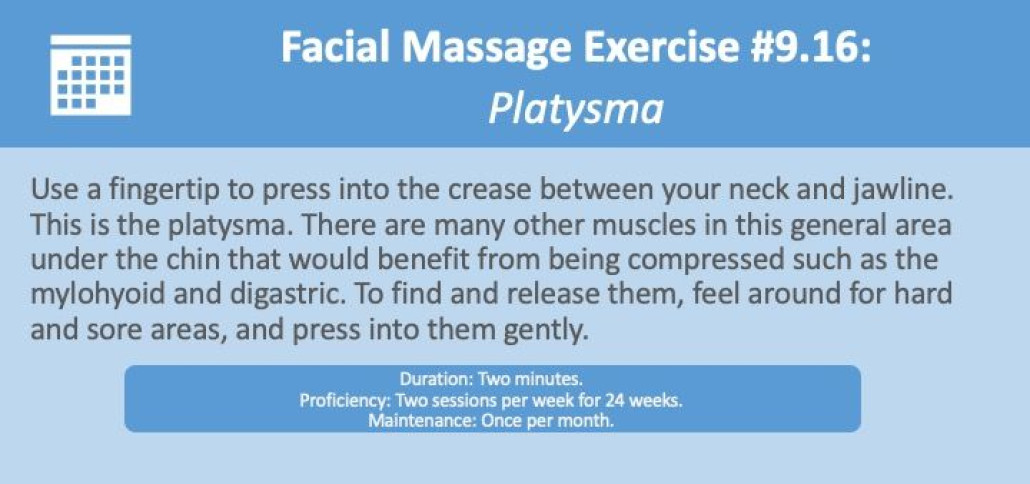

Myofascial Face Massage Of The Chin: Mentalis, Depressor Anguli Oris, Depressor Labii Inferioris
Myofascial facial massage and cosmetic compression of the muscles in your chin will help it look lean and muscular. However, be advised that it may also reduce the chin’s overall size as these muscles metabolize the surrounding fat. I had a painful knot of hard muscle in my depressor labii inferioris the size of a tootsie roll. Weekly compression made it smaller and smaller until it was unnoticeable. Again, this muscle is responsible for the cry-face seen in apes and humans. There is practically no scientific study on the muscular aspects of the cry-face, so I won’t even speculate on what removing these painful knots has done for my psyche. However, I imagine that it is overwhelmingly positive.
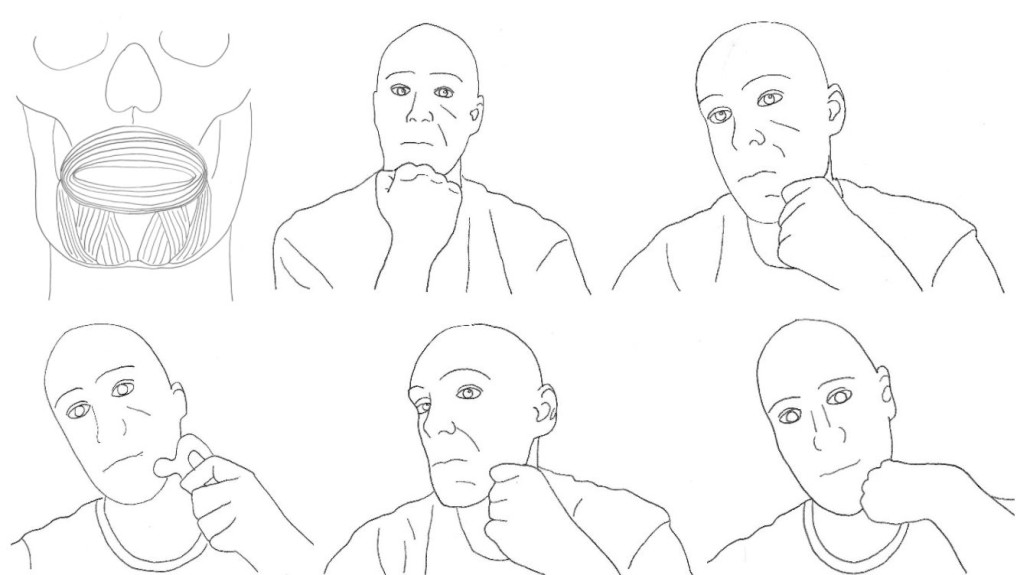
Myofascial face massage illustration: Chin massage.
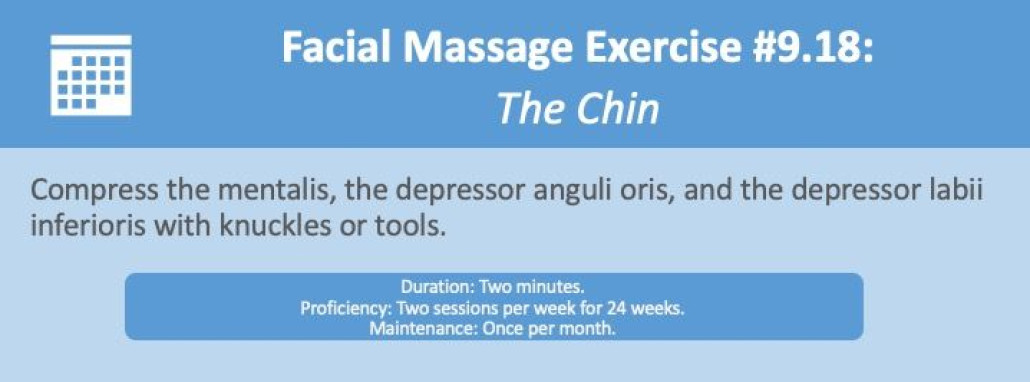
Keep Doing Myofascial Face Massage Exercises
The exercises above may seem time-consuming but focus on the ones you find most interesting or potentially helpful. After a bit of practice, they’ll become automatic, and you will find yourself doing them while watching TV or reading. The slower your diaphragmatic breathing is, the easier it will be to release the muscles. Given the easy, rapid results I experienced, I am amazed facial muscle release regimens are not widespread. I have concluded that without diaphragmatic breathing, tense muscles are too recalcitrant to make such a regimen feasible.
The main thing is to keep at it. Each exercise above provides suggested durations for achieving and maintaining results, but those are just guidelines. The only real standard is how you feel: how your face looks, and how your moods and thought patterns are affected. Give each exercise at least a few weeks before reaching a verdict, experimenting with different tools and small changes in pressure, angle, and rhythm. You’ll soon find a method that works best for you.
Benefits to Your Skin After Myofascial Face Massage
In addition to the myofascial release that you’re expecting by now, myofascial facial self-massage has an additional benefit as well: cosmetic improvements to your skin. Skincare is a huge industry, with hundreds of millions of people trying to achieve a clear, even skin tone using tanning, moisturizers, toners, serums, lasers, masks, and surgical treatments. These can become extremely technical and remarkably expensive. They also mostly fail to address the root cause of skin problems: our skin is designed to handle a great deal of contact and use. It becomes stiff and unhealthy without physical stimulation.
When the face is not handled, tugged, or pulled for many years in a row, the system of blood vessels (or “vasculature”) slowly diminishes. The result is a pale, sallow appearance that accentuates the prominence of moles, freckles, and wrinkles. The exercises presented in this chapter lightly stretch your skin, causing the creation of small blood vessels—a process known as “angiogenesis.” Angiogenesis will make your skin darker, healthier, younger, and more evenly toned. The mechanical sheer forces also cause very slight damage to cutaneous and subcutaneous tissues, prompting the rebuilding and revitalization of countless dermal structures.
Benefits to the Structure of Your Face
Myofascial face Self-massage affects your facial muscles’ shape and structure, which means it shares some similarity with treatments like cosmetic surgery and Botox injection. Botox paralyzes the muscle, decreasing tone and metabolic activity, thereby temporarily decreasing the strain muscles are under. It is popular because it makes a face appear relaxed and reduces the appearance of wrinkles. As discussed in the previous chapter it also has positive emotional effects. For instance, it can reduce negative emotions and susceptibility to crying. Botox has downsides, however. The paralysis prevents muscles from contracting, which vastly reduces the flow of blood, oxygen, and nutrients to them. That, in turn, causes the muscles to atrophy and become weak. Besides these underlying problems, Botox and cosmetic surgery create an artificial look that many people can recognize. Also, Botox cannot be injected near the eyes because there is a risk it could leak into and paralyze the ocular muscles that control eye movements.
Your most beautiful face is not the one that a cosmetic surgeon can give you. They will attempt to create a face that looks muscular, lean, and without tension, without actually giving you any of these things. The surgeon’s needles and scalpel traumatize soft tissues, reduce blood flow, and damage muscles without doing anything to reduce strain. Even the most skilled surgeon cannot come close to creating an all-natural look. This is a limitation inherent in their procedures, tools and techniques.
Compression comes with none of these risks and harms, and it costs nothing. It does take longer, and it can be uncomfortable, but it has much more dramatic, authentic, and longer-lasting effects. Furthermore, surgery and Botox crimp facial expressions, whereas compression grants you greater control over them. For example, my chin and cheeks moved sluggishly before with a reduced range of motion. Now they are surprisingly brisk and nimble.
More than this, muscular release just feels good. Today, I smile wider and more frequently than I ever have, but my facial wrinkles are less pronounced. That and numerous other observations have suggested to me that wrinkles in the skin don’t necessarily come from using the muscles. Rather, wrinkles are more likely to form over strained, dormant muscle.
Scientists have long questioned what it is that constitutes physical beauty. The academic consensus now points to smooth skin, well-proportioned features, the appearance of youth, symmetry and being close to the population averageness.More than these other criteria, I think that the absence of facial muscle strain is the primary determinate of attractiveness. In fact, the extent of facial tension can probably be seen as a marker of the status hierarchy that we wear on our faces.
Be Dominant but not Domineering
As your face become less tense, you will become more dominant. As your composure improves, people in your life, as well as people on the street, will be more respectful. Because of this, you might notice that you start to desire respect and even submissive displays from others. You will inevitably find yourself asserting your will over others in an arrogant way, whether inadvertently or not. You might find yourself holding your head high, looking above the eye line, with a perfectly calm face until another person feels compelled to look down. You might stare at a stranger on the street until they look away. This is not good or just. Keeping a stolid composure is good, but you will generate animosity if you intentionally elicit subordination displays from others.
If you combine your reprogrammed displays with rude comments and antagonizing behavior, there will be a backlash. This could result in losing a best friend, or literally being mauled in the street by strangers. This is an immensely serious point. Be humbler than you were before. If you are going to walk around without sneering or raising your eyebrows, retaining humility is imperative. The person that carries a big stick and speaks loudly must choose their words carefully.
Before, my face belonged to everyone else. They knew this, and they toyed with it. My default facial expression was what they made it. Today my face belongs to me. What will you do with your face now that you have a choice in the matter?
Conclusion: Myofascial Face Massage Exercises
A few years ago, my cat got into an unhealthy habit of showing me with his face how hungry he was. His cries would be accompanied by pitiful facial wincing. His eyes would become tight, and his whole face would crinkle up. When I saw it, my face would empathically do the same. It pulled at my heartstrings. Here is a species, removed from humans by 85 million years of evolution, that uses remarkably similar facial signaling for distress. Of course, I started feeding him more regularly, but I also started massaging his face.
Every few weeks, I hold him in my lap and use my knuckles to gently press into his orbits, cheeks, nose, and jawline. It was uncomfortable for him at first. He found it the most uncomfortable when I used my thumbs to raise and press into his upper lips. Clearly his sneer, like mine, was strained. After four or five sessions, I could tell that it had become painless for him. He never makes those deplorable faces anymore, and people regularly comment on his poise and beauty. He showed dramatic aesthetic facial improvements even though I did not begin this routine with him until age 10.

Myofascial face massage illustration: A. My cat Niko at age 11; B. Niko again at 16. Both pictures exhibit a lack of facial tension.
I recommend that people consider releasing the facial muscles, not only of their pets, but also of their spouses and children. As in the pruning of a bonsai, the sooner you can begin your manipulations, the more dramatic the effects will be. The exercises above act as a guide, but you really want to compress every square inch of your face.
When you have found an area of your face or spine that is tender and sore to gentle pressure, you have uncovered a gold mine. You have discovered a location that, when rehabilitated, will allow personal and spiritual growth. You will experience decreased chronic stress, improved sleep, the release of emotional tension, and better autonomic balance. Whether you are a child, an elderly person, or anything in between, I implore you to compress all the pain out of your face.
Bullet Points Myofascial Face Massage
- Deep tissue compression and percussion will reduce bracing, dormancy, and hypertonia in your facial muscles.
- Pressing firmly into any muscles that ache while breathing diaphragmatically will pull them out of partial contraction, making you more attractive and better composed.
- Massaging your face will make it so that you rarely experience social fatigue and so that your resting face is inviting and receptive.
- Your facial muscles will become more prominent and will have increased range of motion.
- Your skin and facial definition will improve. Your face will appear leaner and will have reduced pain and inflammation.
- Your neutral “resting” face will become authentic and it will be easier to be expressionless.
- Being expressionless and keeping a stolid composure is empowering. However, keep in mind that you will generate animosity if you use your composure to elicit subordination displays from others.
- Aside from the physical benefits there are emotional benefits as well because you are wiping out the low-grade wincing and frowning and the related microexpressions.
Endnotes
- Eckman P. (2003). Emotions revealed. Henry Holt and Co.
- Havas, D. A., Glenberg, A. M., Gutowski, K. A., Lucarelli, M. J., & Davidson, R. J. (2010). Cosmetic use of botulinum toxin-A affects processing of emotional language. Psychological Science, 21(7), 895–900.
- Valentine, T., Darling, S., & Donnelly, M. (2004). Why are average faces attractive? The effect of view and averageness on the attractiveness of female faces. Psychonomic Bulletin & Review, 11(3), 482–487.
- Program Peace by Jared Edward Reser is licensed under a Creative Commons Attribution-NonCommercial-ShareAlike 4.0 International License.
Based on a work at www.programpeace.com
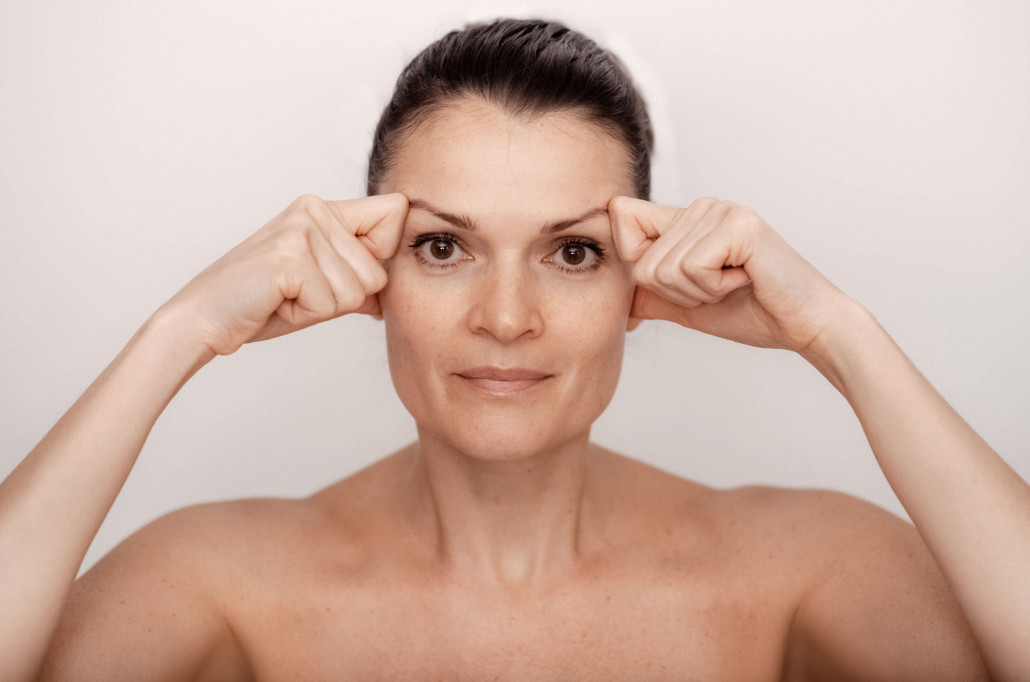
Myofascial Facial Massage Video Program: Myofascial release for the face — Stress off!
The program is medically reviewed by Tatiana Zuzina Massage Therapist, Osteopath and Chiropractic from Tartu University, Estonia, Tallinn. Copyright DIY Beauty School 2024.
